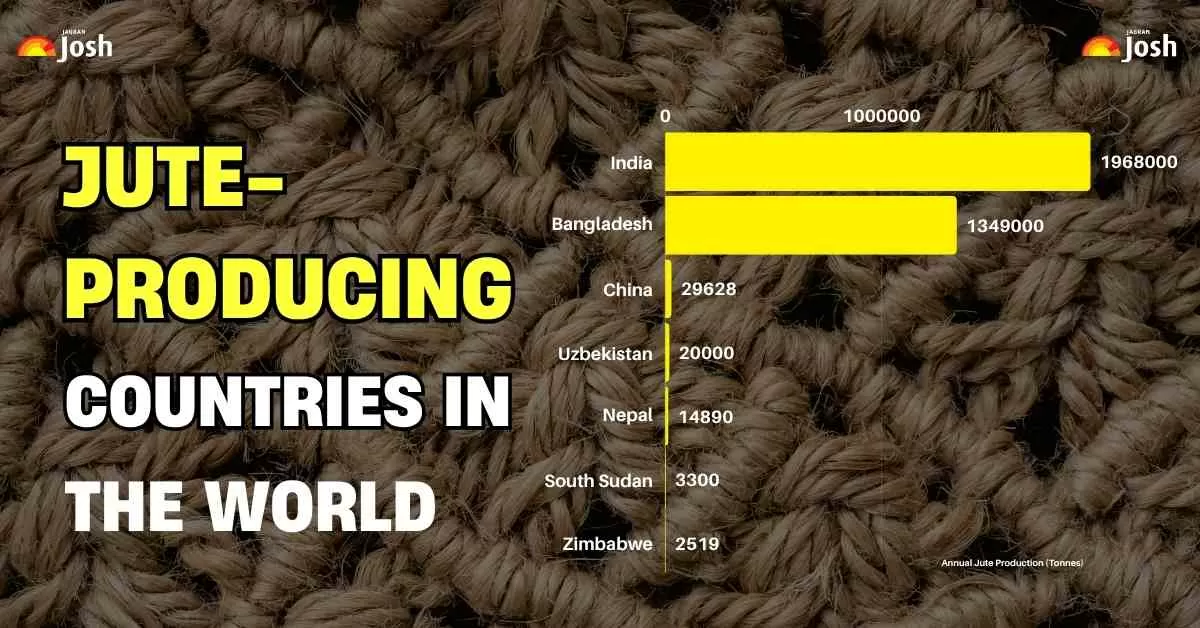Jute is a natural fibre often called the “golden fibre”. It comes from the stems of Corchorus plants. Jute is strong and biodegradable. It is used for bags, ropes, mats, and packaging. This makes it eco‑friendly.
Jute grows best in warm, wet regions with fertile, alluvial soil and thrives in monsoon climates. Most jute is grown in the Ganges Delta, which spans India and Bangladesh. In India, it is mainly grown in West Bengal, Assam, Bihar, Odisha, and Andhra Pradesh.
India is the world’s largest producer of jute. It makes around 1.7–2.0 million tonnes each year. Bangladesh is the second largest, producing about 1.35–1.68 million tonnes.
In this article, we'll take a look at the top five countries producing jute. We'll explore their annual output, growing regions, and roles in the jute industry.
List of the Top 5 Largest Jute-producing Countries in the World
According to the National Jute Board and WorldAtlas, here are the top 5 largest jute-producing countries in the world:
| Rank | Country | Production (2023–24, tonnes) |
| 2 | India | 1,968,000 |
| 2 | Bangladesh | 1,349,000 |
| 3 | China | 29,628 |
| 4 | Uzbekistan | 20,000 |
| 5 | Nepal | 14,890 |
| 6 | South Sudan | 3,300 |
| 7 | Zimbabwe | 2,519 |
| 8 | Egypt | 2,508 |
| 9 | Brazil | 1,172 |
| 10 | Vietnam | 970 |
1. India
India is the world’s top jute producer, with roughly 1.72 million tonnes yearly. It has around 80 jute mills, mainly in West Bengal and nearby states.
While about 90% of the fibre is used domestically for packaging, flooring, and hessian goods, exports exceed $450 million, reaching markets like the US, UK, France, and Germany.
The main jute-producing states in India are West Bengal, Bihar, Assam and Meghalaya. Among them, West Bengal stands out, contributing over 60% of the country's total jute production.
Government policies mandate jute sacks for grains and sugar, boosting internal demand. It offers sustainable packaging and supports over 400,000 workers.
2. Bangladesh
Bangladesh, the birthplace of high-quality white jute, is the world's second-largest jute producer, producing approximately 1.68 million tonnes per year.
It’s the top global exporter, shipping around 200,000 tonnes of raw fibre, plus another 200,000 tonnes of jute goods like yarn and twine. The sector employs hundreds of thousands and exports over $400 million in jute yarn alone.
Major jute-growing regions in Bangladesh include Tangail, Dhaka, Jamalpur, and Faridpur. Although the total area under jute cultivation has declined recently, Bangladesh continues to lead the global jute trade, accounting for around 70% of international jute exports.
3. China
China produces around 15,700–29,600 tonnes of jute annually, ranking fourth worldwide. Cultivation occurs mainly in southeastern provinces—Hunan, Guangdong, and Yunnan—leveraging humid climates.
While production is still secondary to cotton, China is increasing output and modernising practices to meet the rising demand for eco-fibres.
4. Uzbekistan
Uzbekistan is the third-largest jute producer, with about 19,000 tons annually. Despite the modest volume, the country emphasises agricultural diversification, with jute contributing to sustainable agriculture and the resilience of cultures.
Production is expanding through small, eco-conscious agricultural initiatives and methods. Uzbekistan's efforts echo global trends about renewable fibres.
5. Nepal
Nepal produces about 10,400 to 10,500 tons of jute annually, being fifth in the world. Its production is concentrated on Terai's fertile plains, near India, with the Biratnagar jute factory as its main installation.
Nepal focuses on organic and sustainable cultivation, meeting local needs and export markets. The jute supports the rural subsistence means and aligns with Nepal's green development priorities.
Which Country is the Highest Producer of Jute in the World?
India is the world's largest producer, contributing approximately 1.72 million metric tonnes annually, which represents about 50% of global production.
Most of the cultivation of the jute of India occurs in the state of West Bengal, benefiting from the fertile soils of the Ganges Delta. The jute is predominantly used in the domestic market for packaging, textiles and other products, with a significant portion also exported.
